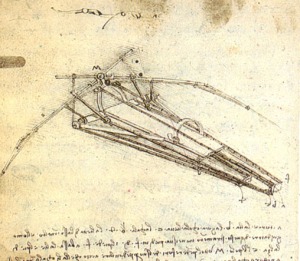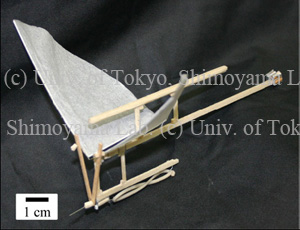I came across a very cool video today morning and that gives this post its name. Before I get into that, I think it would be much desirable to give an introduction to Ornithopters in general and talk about some robotic ornithopters. For those interested solely in the video, well it is at the end of the post (second last video).
______
Introduction
An Ornithopter basically means an aircraft (even a robot) that can fly by flapping its wings. Though the word might sound complicated initially (Although the prefix Ornith- is well known). All of us at some point in time (whether as a childhood fantasy or as a serious hobby or professional work) have wanted Ornithopters. Ornithopters have been a fantasy since very ancient times, and it is obvious to have been as birds have always fascinated and amazed humans. There have been many reported Ornithopters in Hindu mythology. Also the legend of Daedalus and Icarus is well known, in which Daedalus designed feathered wings to fly out of the island of Crete on to which he was imprisoned.
The legendary Leonardo Da Vinci – A genius imprisoned in a time where his ideas just could not have been realized, made some designs of Ornithopters and other glider type flying machines (but let’s avoid machines that do not have any moving wings in this post, though some are very cool). Some of which were very good engineering designs.
Click to Enlarge
Though we tend to regard the idea of wing powered machines as failed because of the success of modern day style aircraft there have been many successful flights. The first reported to have flown successfully was made in 1929 by Alexander Lippisch, it flew about 300 meters before the flight was terminated due to the obvious limitations of human muscle power. A number of motorized ornithopters have been made since then. A number of people take Ornithopters as a serious hobby.
______
Modern Ornithopters
These days though, the interest has been more in ornithopters that resemble insects, such as bees, both as toys and sophisticated autonomous flying spy robots. The size of such Miniature Aerial Vehicles would ensure they are impossible to detect and hence are perfect for spying missions. Especially in the case of urban warfare when the opposing party might be holed up in a building. Thus, needless to say these can be very helpful in counter-terror operations. The aim in making such bots would be to make them very low cost with flight times as high as 5-6 hours. Let me cite some examples of some cool miniature aerial vehicles of the ornithopter category.
After some early feasibility studies done at the Lincoln laboratories at the MIT, DARPA in 1997 began a multi-million dollar program to make some sophisticated Miniature Aerial Vehicles (MAVs), some of the designs and projects also included ornithopters.
One such ornithopter was the MicroBat ornithopter developed at the California Institute of Technology along with AeroVironment and UCLA.
[The MicroBat Ornithopter, Image Source]
This paper reports the making of the MicroBat Ornithopter. The excerpt to the paper:
This paper reports the successful development of “Microbat,” the first electrically powered palm-sized ornithopter. This first prototype was flown for 9 seconds in October 1998. It was powered by two 1-farad super capacitors. Due to the rapid discharge of the capacitor power source, the flight duration was limited. To achieve a longer flight, a rechargeable battery as a power source is preferred. The second prototype houses a small 3-gram rechargeable Ni-Cad battery. The best flight performance for this prototype lasted 22 seconds. The latest and current prototype is radio-controlled and is capable of turning left or right, pitching up or down. It weighs approximately 12.5 grams. So far, the best flight duration achieved is 42 seconds. The paper also discusses the study of flapping-wing flight in the wind tunnel using wings developed by MEMS technology. This enables a better understanding the key elements in developing efficient wings to achieve aerodynamic advantage in flapping-wing flight.
Another research group led by Robert C. Michelson made another Ornithopter called the Entomopter. This went one step ahead and can be called a milestone in MAV ornithopter development. The aim was to closely mimick the flight of birds and thus totally eliminate the usage of gears and motors. The entomopter is driven by wings that are driven by a reciprocating chemical muscle.
Click to Enlarge
______
Ornithopter Toys
There are now a number of companies that offer ornithopter toys. One of the most well known probably is the FlyTech Dragonfly from WowWee, It is a remote controlled wireless ornithopter. It seems like a pretty fun toy. You can see a video on this toy here >>
 [FlyTech DragonFly Ornithopter]
[FlyTech DragonFly Ornithopter]
A number of people take making ornithopters as a very serious hobby. If you wish to make one, then I would direct you to this page.
______
Butterfly Ornithopter
Finally I come to the part that gave this blog post its title. ;-)
In a paper at IROS 2008, researchers from the Shimoyama – Matsumoto Lab at the university of Tokyo presented their work on an extremely light butterfly ornithopter.
[Butterfly Ornithopter: Image Source]
The artificial butterfly wing consists of a thin polymer membrane which is supported by viens of plastic having rectangular cross section. The purpose of this paper was to study the effect of veins on the performance of flight. The parameters for this “butterfly” are more or less comparable to that of an actual butterfly.The weight of the ornithopter including the wings is just about 0.39 gms and the flapping frequency 10 Hz.
Here is a fantastic video of the Ornithopter depicted in the figure above:
______
Some more work on Ornithopters at Shimoyama – Matsumoto Lab:
Since I have just mentioned the work on the Butterfly Ornithopter, there is some cool work going at the Shimoyama – Matsumoto Lab on ornithopters.
>> Dragonfly Type of Ornithopters
>> Butterfly Type of Ornithopters
>> Hovering Flight of Ornithopters
[Hovering Type Ornithopter: Image Source]
______
Bio-Inspired Flying Robots
Finally before ending, I would like to post a bonus video ;-)
This video was the winner at the AAAI – 08 video contest. Like the video on Morphogenesis (Swarm Intelligence) which I posted about 10 months back, which was also a winner in the same contest, this video too is excellent.
______
Quick Links:
1. MAVSTAR – Micro Aerial Vehicles for Search Tracking and Reconnaissance.
2. A Reciprocating Chemical Muscle for Micro Air Vehicle “Entomopter” Flight – GTRI
3. Nano Air Vehicle – DARPA
4. Ornithopter Zone – Excellent site for the hobbyist.
5. Project Ornithopter – Project on making Ornithopters on a much larger scale than those discussed in this post.
______









